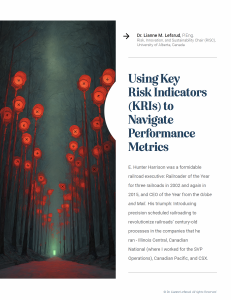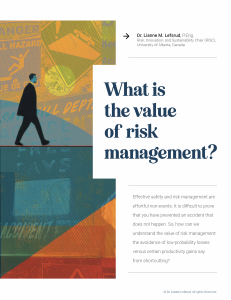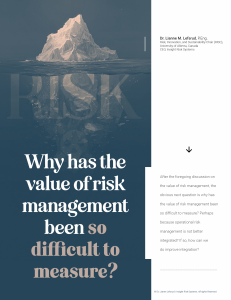What are Key Risk Indicators and how to best use them?

Think Piece Kpis
This white paper by Dr. Lianne Lefsrud tackles a fundamental challenge in operational risk management: organizations have too many performance metrics that fail to meaningfully predict or prevent major incidents. Using the case study of railroad executive E. Hunter Harrison—who transformed Canadian National’s profit margins from ~0% to 40% by cross-referencing previously siloed metrics—the document demonstrates how the right indicators create value and integration while scattered measurements undermine corporate performance.
The paper presents a systematic framework for developing effective Key Risk Indicators (KRIs):
- Connecting KRIs to specific hazards rather than using generic safety pyramids. Organizations should map their company-killer scenarios (facility explosions, dam failures, data breaches) using Bowtie Diagrams that identify causes, consequences, and controls for each loss-of-control event.
- Focusing on leading indicators that drive behavior, not just measure outcomes. The best KRIs are valid, predictive, behavioral-based, offer timely feedback, show sensitivity to small improvements, and motivate continuous improvement—while avoiding metrics that can be gamed or create perverse incentives.
- Creating line-of-sight from daily decisions to strategic goals by ensuring input variables predict process variables, which predict output variables, and that managers can actually control and are rewarded for managing these indicators effectively.
- Decluttering through systematic evaluation by creating enterprise-wide summary tables of all KPIs/KRIs across business units, correcting inconsistencies, deleting redundancies, and using machine learning to validate which indicators actually predict incident frequency and consequences.
Why It Matters
For leaders and executives, the paper reveals how scattered performance metrics (“if everything is a priority, nothing is”) waste management effort and create blind spots to catastrophic risks. The example of frontline supervisors held accountable for injury rates while lacking control over competency and turnover illustrates how misaligned indicators drive incident suppression and burnout rather than safety improvements.
For risk and operations professionals, it provides concrete criteria to evaluate existing metrics—like whether they measure what people do versus fail to do, qualify the quality of activities beyond counting them, and tie to human/organizational vulnerabilities like psychological safety. The guidance on composite indicators (safety:efficiency ratios), conversation analytics for measuring psychological safety, and avoiding gameable metrics offers practical alternatives to traditional lagging indicators like LTIR and TRIR. The document also challenges the ubiquitous but misleading safety pyramid, noting that no constant ratio exists between minor and major incidents across companies.
Download Insight Risk Systems’ Insight Risk Systems THINK PIECE: What are Key Risk Indicators and how to best use them? by Dr Lianne Lefsrud.



